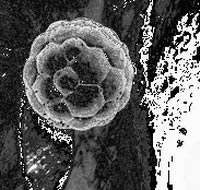Appearance can identify stem cells
Danh Phuong
Some scientific results are difficult to identify, especially in genetic research. Often, scientists cannot naturally know the gene they inserted into a cell will give them the characteristics they once desired. To overcome this problem, the researchers used various genetic markers, containing foreign DNA, such as making cells glow when they were exposed to ultraviolet light.
But scientists in the lab of Whitehead Member Rudolf Jaenisch did not need to use genetic markers in their latest experiments, because the results were easy to see. Based on the advertised Nature article in June, the report explains it is possible to convert specialized mouse skin cells into unspecialized stem cells.
Their findings are published online in Nature Biotechnology , which brings human stem cell healing to a step closer to reality. Before reprogramming can be applied to our own form to produce normal stem cells, scientists must be able to complete it without changing the cell's DNA. mandarin
"This eliminates one of the main obstacles to reprogramming cells in humans ," said Jaenisch, a biology professor at the Massachusetts Institute of Technology . If we overcome other obstacles, this method could one day provide us with ordinary stem cells for healing purposes. '
 (Photo: Dost-dongnai.gov.vn) Last spring, Wernig and Meissner relied on genetic markers to successfully identify reprogrammed cells. That requires them to work on fibroblasts taken from genetically modified mice. The mouse was raised from embryonic stem cells that carried foreign DNA coding for antibiotic resistance. Scientists have imbibed strange DNA markers in specific locations systematically along the genome, next to the only genes expressed in embryonic stem cells. All cells from the mouse carry the standard mark.
(Photo: Dost-dongnai.gov.vn) Last spring, Wernig and Meissner relied on genetic markers to successfully identify reprogrammed cells. That requires them to work on fibroblasts taken from genetically modified mice. The mouse was raised from embryonic stem cells that carried foreign DNA coding for antibiotic resistance. Scientists have imbibed strange DNA markers in specific locations systematically along the genome, next to the only genes expressed in embryonic stem cells. All cells from the mouse carry the standard mark.
In the first experiment, the researchers took fibroblasts from the tail of the mouse and infested them with a special virus containing 4 genes (Oct4, Sox2, c-myc, and Klf4) that could be possible. the ability to convert cells into embryonic germ state. These genes are particularly active in embryonic stem cells, beginning to make the adjacent DNA adjacent to the antibiotic resistant. Therefore, only fully reprogrammed cells exist with antibiotics, and this helps scientists isolate them.
Wernig said: 'When we conducted the first experiment, we noticed that many infected cells began to change shape before the markers were activated.'
Therefore, they created a new experiment to check whether eye recognition alone is effective. Indeed, under a microscope, based on a few natural differences, they separate reprogrammed cells from normal fibroblasts. Fibroblasts are large and flat. Stem cells are shaped into very compact, round and small clusters.
Meissner said: ' We have shown that in order to successfully separate programmed cells there is no need to use standard markers. This greatly simplifies the method of experimentation on mice, because we can now do research with conventional fibroblasts . '
But there is still another obstacle before this technique can be applied to human cells. Meissner explains: 'We still use viruses that contain foreign DNA to introduce genes that can bring reprogramming.'
Currently, scientists are working to eliminate viruses generated by the reprogramming process. Jaenisch believes they will succeed and work out a technique that will provide a plentiful supply of normal human embryonic stem cells for healing purposes.
Meissner and Wernig successfully reprogrammed about 0.5% of fibroblasts. This suggests that there are millions of cells in a typical skin biopsy method (researchers use skin taken from both ends of the tail and from the ears of the mouse), turning into thousands of stem cells. Each stem cell has the ability to grow inside any type of cell of the body.
Note: This report is adapted from a news release published by the Whitehead Institute of Medical Research.
- 10 ways stem cells promote medical development
- Stem cells will be taken to the ISS station for observation
- Identify stem cells that can heal damage in the heart
- What are stem cells? How advanced is medicine in this area?
- It was possible to transplant stem cells from one person to another
- Detecting 'multipurpose' stem cells helps cure many diseases
- Molecular detection helps extract stem cells for blood cancer treatment
- Successful development of pork from stem cells
- Can skin cells turn into eggs and sperm?
- Successfully transformed stem cells into lung cells
- Turn stem cells into cells of the intestine, pancreas
- Successfully created kidney cells from stem cells
 Why do potatoes have eyes?
Why do potatoes have eyes? 'Tragedy' the world's largest carnivorous life: Death becomes ... public toilet
'Tragedy' the world's largest carnivorous life: Death becomes ... public toilet Tomatoes were once considered 'poisonous' for 200 years
Tomatoes were once considered 'poisonous' for 200 years Detecting microscopic parasites on human face
Detecting microscopic parasites on human face